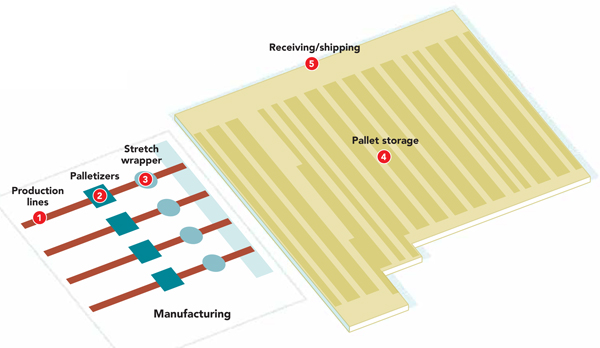Scotts Miracle-Gro: Keeping up with peak demand
Lift trucks, stretch wrap and floor storage are at the heart of Scotts’ distribution activities.
Latest Material Handling News
Registration open for Pack Expo International 2024 Walmart chooses Swisslog AS/RS and software for third milk processing facility NetLogistik partners with Vuzix subsidiary Moviynt to offer mobility solutions for warehouses Lucas Watson appointed CSO for Körber’s Parcel Logistics business in North America Hyster recognizes Dealers of Distinction for 2023 More NewsThe Scotts Miracle-Gro Company; Marysville, Ohio
Size: 780,000 square feet
Products: Lawn and garden products
SKUs: 144
Throughput: 9,150 pallets a day received and shipped during peak season
Shifts: 3 shifts a day/7 days per week during peak season
Employees: 85 people in distribution
The Scotts Miracle-Gro distribution center in Marysville, Ohio, exemplifies conventional storage and distribution. The manufacturing process is highly automated, right through the bagging, palletizing and stretch wrapping processes. But once pallets have been prepared for shipment, they are stored on the floor and moved by lift trucks outfitted with attachments to handle two pallets at a time.
Receiving: Scotts operates multiple production lines (1) in the facility. At the end of each line, the product being mixed is automatically bagged, palletized (2), stretch wrapped and ring wrapped (3), labeled and automatically scanned. It is now in the warehouse management system and ready for putaway into storage (4). While that represents the bulk of the product stored in the facility, some product is received (5) from other Scotts’ facilities. Those pallets are scanned as they’re unloaded from the trailer.
Storage: The storage process is the same whether the product is coming directly from the manufacturing line or has just been received in a truck. A lift truck operator scans the pallet and chooses a storage location (4) in an area where other pallets with the same SKU are being stored. At the storage spot, the operator scans a location tag to confirm the putaway location for that pallet. All product is stored on the floor utilizing a pyramid stacking pattern. The bottom layer of the pyramid is five pallets across; successive layers have fewer pallets while the top of the pyramid may be one or two pallets.
Picking: Order fulfillment is managed by Scotts’ enterprise resource planning (ERP) system. Pick tickets associated with an order are printed and distributed to lift truck operators. Once the lift truck operator arrives at the storage location (4) associated with a pick ticket, the operator scans the location bar code label before picking up a pallet.
Packing and shipping: Most of the pallets picked during the second shift are loaded directly from storage onto a trailer at the docks in the receiving/shipping area (5). The operator scans a location tag to confirm that the pallet is loaded onto the correct trailer at the right dock door. Pallets picked on the first and third shifts are typically staged on the loading dock. They are then loaded during the second shift.
System suppliers
Lift trucks: Toyota Material Handling U.S.A.
Fleet management provider: Toyota Material Handling Ohio
Lift truck attachments: Cascade Corp.
Palletizer: Packaging Systems International
Stretch and ring wrap equipment: Lantech
ERP/Warehouse management system: SAP
Mobile computing: Motorola Solutions
Article Topics
Latest in Materials Handling
Registration open for Pack Expo International 2024 Walmart chooses Swisslog AS/RS and software for third milk processing facility NetLogistik partners with Vuzix subsidiary Moviynt to offer mobility solutions for warehouses Materials Handling Robotics: The new world of heterogeneous robotic integration BSLBATT is looking for new distributors and resellers worldwide Lucas Watson appointed CSO for Körber’s Parcel Logistics business in North America Hyster recognizes Dealers of Distinction for 2023 More Materials HandlingAbout the Author
Subscribe to Materials Handling Magazine

Find out what the world's most innovative companies are doing to improve productivity in their plants and distribution centers.
Start your FREE subscription today.
April 2024 Modern Materials Handling

Latest Resources












